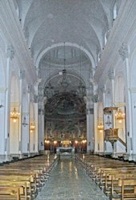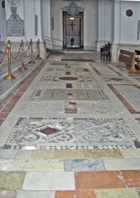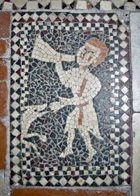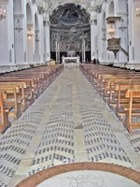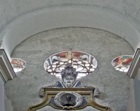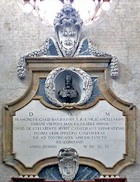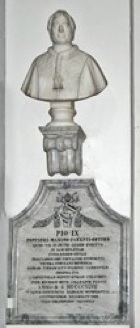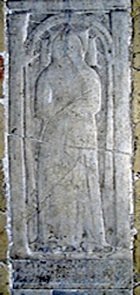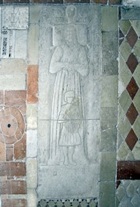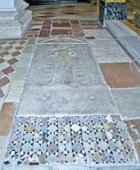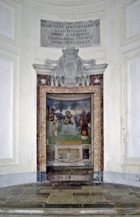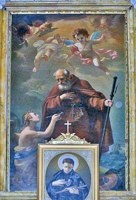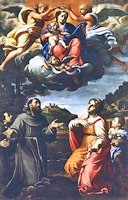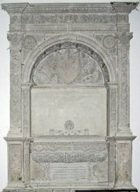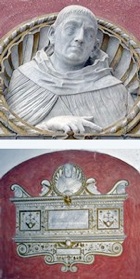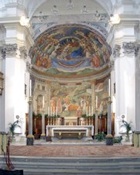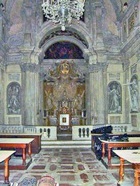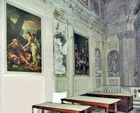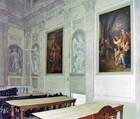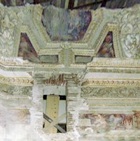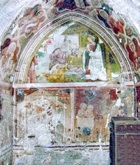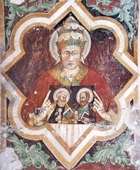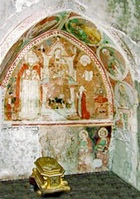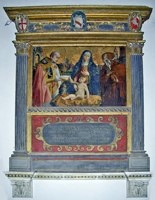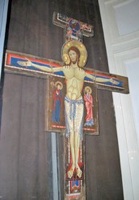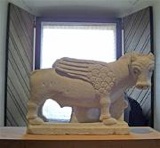As is set out in more detail in the home page on the Duomo, the interior took on its current appearance after two remodelling projects:
-
✴that undertaken at the behest of Cardinal Francesco Barberini, which was largely carried out in 1638-44 and completed in ca. 1680; and
-
✴that undertaken by Bishop Cardinal Francesco Maria Locatelli in 1785-92 to designs by Giuseppe Valadier.
Pavement
The pavement in the nave is largely original or recomposed using parts of the original. Two distinct phases are evident:
-
✴The part nearest the apse, which is probably the earlier, is made up of areas of geometric patterns.
-
•Part of a narrative of a hunt scenes survives on the right, in the raised pavement above the steps leading to the apse.
-
✴The part nearest the counter-facade is of a chevron design.
The pavement in the side aisles was laid in the 15th century.
Counter-facade
Fresco fragments (1370s)
These fragments, which belonged to a fresco of the Last Judgement commissioned by Bishop Gallardus (1372-8), came to light during the recent restoration of the Duomo.
-
✴Fragments of angels, some blowing trumpets can be seen in the upper part of the recesses around the rose windows.
-
✴More difficult to see are the remains of a fresco of Christ in Judgement, above the central rose window.
Copy of the Portrait Bust of Pope Urban VIII (ca. 1640)
A surviving document records that Pope Urban VIII commissioned this bronze bust from Gianlorenzo Bernini for the Duomo. The commission was made in memory of his years as its bishop (1608-17). The bust arrived in Spoleto in 1644 (the year in which Urban VIII died) and was placed in the niche in the inscription on the counter-facade of the Duomo that commemorates the contribution made by his nephew, Cardinal Francesco Barberini, towards the remodelling of the church. It was replaced by a copy in 1998, when the original was moved to the Museo Diocesano.
Nave
The nave was widened and the narrowed aisles were heightened in the remodelling of 1638-44. The new colonnades that were built to separate the nave from the aisles are decorated with bees from the Barberini arms.
Pope Pius IX (1847)
This statue of Pope Pius IX, which stands by the 6th column on the right, commemorates the fact that he financed the restoration of the campanile in 1847. Before his election, Giovanni Maria Mastai-Ferretti had been a much-loved bishop of Spoleto (in 1827-32).
Floor Tombs (15th century)
The floor tombs of three women, which were originally in front of the high altar, were inserted in the raised pavement above the steps leading to the apse during the remodelling of 1638-44.
-
✴The tomb of Andreola Tomeo dei Bosi (died 1451), the mother of Pope Nicholas V, is at the front on the right. This tomb is associated with payments made in 1468 to the sculptor Pencia di Marianillo. Andreola had lived in the Rocca from 1447 until her death while Cardinal Filippo Calandrini, her son by her second marriage, was the castellan. She is shown lying with a child upon her legs (not legible in this photograph), although it is not clear which of her sons is represented. The tomb contains the arms of Cardinal Calandrini.
-
✴The tomb behind that of Andreola Tomeo dei Bosi belongs to Violante Ricci (died 1483), the niece of Pope Sixtus IV. He appointed her husband, Domenico Gentile Riccio as castellan of the Rocca in 1478. She too is shown lying with a child upon her legs. This is presumably her son by a previous marriage: Cardinal Raffaele Sansoni Riario.
-
✴The tomb in the pavement on the opposite side of the apse is that of Bianca (died 1481), the daughter of Violante and Domenico Gentile Riccio.
Right Aisle
The altars in the right aisle were installed as part of the remodelling of 1785-92.
Eroli Chapels
The entrance in the 1st bay leads to the Eroli Chapels. The inscription above the entrance records the fact that Bishop Francesco Maria Loccatelli commissioned the the redesign of the interior in 1785. The original façade of this chapel was moved back by about 30 cm at this time.
Blessed Gregory and Angels (ca. 1792)
This altarpiece, which is on the 4th altar on the right, is signed by Pietro Labruzzi. Blessed Gregory of Spoleto is depicted as a pilgrim to whom an angel offers the relic known as the Sacro Chiodo (a nail that had been used in the Crucifixion of Christ).
This altar probably marks the location of the chapel that originally housed the relics of the Blessed Gregory (see below).
Right Transept
The five-sided Cappella di Santa Caterina (14th century) which Benedetto Gelosi remodelled in 1597, was demolished in the remodelling of 1638-44, which involved the rebuilding of the transepts. Giuseppe Valadier designed the altar (ca. 1785) on the back wall.
Madonna and Child with Saints (1599)
This altarpiece, which is now on the altar on the back wall, is the only part of the decoration of the Cappella di Santa Caterina that survived its demolition in ca. 1638. Benedetto Gelosi commissioned it from Annibale Carracci two years after he had acquired the chapel. It was painted in Rome and is probably mostly a workshop production.
The panel, which had to be increased in height (not shown here) when it was inserted into the new altar, depicts the Madonna and Child with SS Francis and Dorothy.
-
✴In the upper part, the Madonna and Child are seated on a cloud. She has golden manna in a fold in her cloak, which the baby Jesus scatters. The angel below carries a scroll with the inscription: "SVB TVVM PRAESIDIVM" (under your protection). This iconography became popular in Spoleto in 1527, when the Imperial troops who marched by the city after the sack of Rome left it largely unmolested. Indeed, commerce with the soldiers proved to be profitable for the city and its merchants. This must have felt like manna from Heaven.
-
✴In the lower part, SS Francis and Dorothy kneel in front of a cityscape showing the Rocca and Ponte delle Torre and intercede with the Madonna and Child for the continued protection of Spoleto. There is another Franciscan to the left of St Francis and a child with a basket of roses to the right of St Dorothy. This child represents Francesco, the son of Benedetto Gelosi, who died in childhood: he had been born on the feast of St Dorothy.
Monument to Giovanni Francesco Orsini (1499-1502)
This monument, which is on the right wall, was originally in Cappella Orsini in the right aisle. A surviving contract records that Conte Nicolò di Pitigliano commissioned it from Ambrogio Barocci for his son, was Giovanni Francesco Orsini, who had died in Spoleto. [Why was he in Spoleto?]
The monument had a number of subsequent locations and was badly recomposed when it was moved to its current location in 1904.
Tomb of Bishop Fulvio Orsini (died 1581)
The floor tomb of Bishop Fulvio Orsini (1562-81) is in front of the monument to Giovanni Francesco Orsini. He is identified by the funerary inscription and depicted in episcopal robes.
Monument to Filippo Lippi (ca. 1488)
This important monument is on the left wall. Filippo Lippi died in Spoleto in 1469 while he was working on the fresco cycle in the apse.
According to Giorgio Vasari, the people of Spoleto buried him in a red and white marble tomb in the Duomo. Lorenzo de' Medici tried to repatriate the body to Florence: this was probably in the 1480s, when Lorenzo was involved in a program to assemble the tombs of a number of famous Florentines in the Duomo of Florence. When the Spoletans refused to release the body, Lorenzo commissioned this more fitting monument to a design by Filippo’s son, Filippino Lippi. He apparently visited Spoleto for the purpose while en route for Rome, probably in ca. 1488.
The new monument was executed by an unknown but probably Florentine sculptor. The Latin inscription by Angelo Poliziano is written in the first person: in it, Filippo says that Lorenzo has given him refuge in a marble sepulchre after his initial poor covering. He also says that he has surprised Nature by his ability to reproduce her work in his art. The Medici arms are depicted under the fine bust of Lippi.
The monument was originally installed over the door to the sacristy. It was moved to the space in front of the Cappella del Sacramento (see below) during the remodelling of 1638-44 and moved again to its present location in 1904 at the behest of Giuseppe Sordini. It is impossible to say how much of the original has been lost.
Cappella della SS Icone
The Cappella della SS Icone, to the right of the apse, houses a venerated icon of the Virgin.
Apse
The original semi-circular apse survived a number of plans for its demolition in order to build a deeper one that would have allowed more room for the canons and other dignitaries during important services. The survival of the original apse was probably due to the existence of the magnificent frescoes (1467-9) of scenes from the Life of the Virgin that were the last works of Filippo Lippi. They were however cut down at the sides during the final remodelling of the Duomo in 1785-92.
The frontal of the original high altar, which Bishop Maffeo Barberini described in his pastoral visit of 1610, is now in Sant' Eufemia. Giuseppe Valadier designed the present high altar (1792). The four granite columns at the corners of the raised pavement on which it stands were a gift from Pope Pius VI.
Cappella del Sacramento (1590s)
This chapel, which is to the left of the apse, is not usually open to the public.
Its stucco decoration (1672-82) is by Giovanni Fontana da Foligno. Bishop Ludovico Sciamanna commissioned the 21 panels in the ceiling, one of which is signed by Francesco Refini and dated by inscription to 1684.
The altarpieces form a cycle on themes related to the Eucharist, including:
-
✴on the left, starting from the door:
-
•Elijah and the angel (1791), signed by Pietro Labruzzi and dated by inscription; and
-
•the last supper (1784) by Liborio Coccetti; and
-
✴on the right, starting from the door:
-
•the fall of the idol, Dagon (1784), signed by Liborio Coccetti; and
-
•the fall of manna to feed the Israelites (1791) by Pietro Labruzzi.
Cappella di S. Anna (14th century)
This originally five-sided chapel (now between the Cappella del Sacramento and the left transept) was originally the pendant of the Cappella di Santa Caterina opposite (see above). Cesare Glandi acquired and redecorated it in 1597. It was reduced in size in the remodelling of 1638-44 to make way for the new transept.
Its frescoes (1597) were removed in the late 19th century, although traces of this decoration can be seen in the upper part of the walls.
The removal of the late 16th century decoration revealed earlier frescoes.
[Fresco of St Peter Martyr, dated 1378 ?].
The aedicule on the left, which contains the arms of the Racani family, contains very damaged frescoes of scenes from the life of St Jerome.
There are two frescoes chapels set into the wall on the right:
-
✴The aedicule on the left, which bears the arms of the Campello family, contained the Altare di San Cipriano, and contains the following frescoes:
-
•the nativity, in the lunette on the back wall;
-
•scenes from the lives of SS Cyprian and Justina, on the lower parts of the three walls, including a scene of their martyrdom in a vat of boiling oil; and
-
•five saints under the arch, including (bottom right) Pope Urban V holding portraits of SS Peter and Paul.
-
✴The aedicule on the right contained the Altare di San Vincenzo Ferrer, and contains the following frescoes:
-
•the Madonna and Child enthroned with Pope Urban V (again holding portraits of SS Peter and Paul) and Jerome, and donor portraits, in the lunette on the back wall;
-
•damaged frescoes of: the Crucifixion (left wall); the Madonna del Latte with saints (back wall); and a saint holding a hammer (right wall); and and
-
•five saints in tondi, including St Paul (bottom left), which is dated by inscription to 1477.
This chapel is not usually open to the public.
Left Transept
Madonna and Child with saints (15th or 16th century)
This altarpiece, which is now on the right wall, probably came from a chapel that was dedicated to the Blessed Gregory of Spoleto after his death in 1473. The marble sarcophagus (1486-8) that housed his relics was noted in 1873 near the Cappella di Sant’ Anna and this might have been the original site of the chapel. (The sarcophagus was removed in 1910 and is now in Room 5 of the Museo Nazionale del Ducato di Spoleto.)
The altarpiece depicts the Madonna and Child with St Clement I and the Blessed Gregory. The chapel acquired an additional dedication to St Clement in 1522: this suggests that the altarpiece was painted at about this time, although stylistic considerations suggest an earlier date.
The ornate frame of the altarpiece bears his arms of Bishop Paolo Sanvitale. He ordered the official recognition of the relics in 1597, and the frame must date to that period. The inscription says that Blessed Gregory died in the company of angels in extreme old age in a hermitage on Monteluco in 1473.
St Pontian with lions (1787)
This altarpiece is on the altar on the back wall. [It was not there during my last visit in January 2009.] It was the first altarpiece to be commissioned for one of the new altars designed by Giuseppe Valadier that were installed in 1785-92. The Commune commissioned the altarpiece after an earthquake shook the city in 1785. St Pontian had apparently saved the city from harm in earthquakes in 1703 and 1767, and he was again its saviour in 1785.
The altarpiece is signed by Cristoforo Unterberger and dated by inscription. Unterberger was related by marriage to Giuseppe Valadier, and this could be the reason that he accepted this provincial commission. Bishop Francesco Maria Locatelli and Pope Pius VI contributed to the substantial cost of the altarpiece, which was probably painted in Rome.
The altarpiece depicts St Pontian among a pride of docile lions in the amphitheatre, prior to his martyrdom in the 2nd century. Angels comfort him with the promise of the palm and crown of martyrdom.
Left Aisle
Cappella delle Reliquie (1540)
The Cappella delle Reliquie is in the 6th bay on the left.
Christus Triumphans (1187)
This painted Crucifix is in the 1st chapel on the left. It was moved here from SS Giovanni e Paolo in 1887.
The inscription at the foot of the cross gives the name "Alberto So.." and the date in Roman numerals. The signature is usually presumed to be that of the artist, who is referred to as Alberto Sotio. If this is correct, this is one of the earliest surviving works of art that bears the date and the name of the artist.
Christ is depicted on the cross with his eyes open, apparently impervious to his pain, as is usual before the 13th century. Full length figures of the grieving Virgin and St John the Evangelist stand to the sides.
-
✴There is an interesting representation of the Ascension of Christ above the cross, in which angels carry Him to Heaven in a mandorla.
-
✴The hills of Golgotha are represented below the cross, and blood from the wounds in Christ's feet flows into the mouth of a skull of Adam.
Art from the Church
The following pieces of sculpture are now in the Museo del Ducato di Spoleto:
Symbol of St Luke (13th century)
This marble statue from the Duomo is now in Room 9.
Architrave (1463)
These surviving fragments from a marble sculpted architrave are now in Room 14. The inscription gives the date and the name of the donor, Canon Filippo di Jacopo.
Panels (1597)
These fifteen panels by Benedetto Bandiera were documented in the vaults of the Cappella di Santa Caterina in the right transept, which Benedetto Gelosi remodelled in 1597. They were subsequently lost, presumably when the chapel was demolished in 1638.


